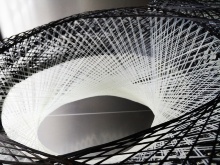Fibrous Morphology
ICD / ITKE Research Pavilion 2014
Natural fiber structures are characterized by highly differentiated geometries with local variation of material properties. These performative morphologies are able to negotiate between multiple, potentially even contrary, fitness criteria through their material organization strategies. Such structures are thereby able to achieve a higher level of functional integration than current technical approaches to architectural fabrication.
Recent developments in computational design methods, material science and fabrication techniques open up new possibilities to transfer functional principles of these natural fiber systems into architectural applications. Students will investigate computational design strategies and fabrication techniques for fibre composite structures in order to identify potential future trajectories while positioning analyzed precedents within the larger disciplinary context.
Based on these initial studies new material-based fabrication concepts and resulting morphospaces will be explored.This explorative and comparative process will be supplemented by the two closely related seminars Architectural Biomimetics and Computational Design Techniques and Design Thinking, which will enable students to investigate related biologic role models in interdisciplinary teams as well as developing suitable computational design tools for this process.
Outcome of these investigations will be an overview of the topic in the context of the dicipline and a series of biomimetically informed fabrication concepts and proposals for their application as proto architectural systems. The most promising concept developed during the design studio will be the starting point for the development and fabrication of the 2014 ICD / ITKE Researchpavilion within the summer term.
Corequisite for participation in the design studio is attendance of the seminar Architectural Biomimetics. Prerequisite is previous participation of the Seminar Computerbasiertes Entwerfen. Final presentations are at the end of WS 2013/2014.
ICD / ITKE Research Pavilion 2014
Natural fiber structures are characterized by highly differentiated geometries with local variation of material properties. These performative morphologies are able to negotiate between multiple, potentially even contrary, fitness criteria through their material organization strategies. Such structures are thereby able to achieve a higher level of functional integration than current technical approaches to architectural fabrication.
Recent developments in computational design methods, material science and fabrication techniques open up new possibilities to transfer functional principles of these natural fiber systems into architectural applications. Students will investigate computational design strategies and fabrication techniques for fibre composite structures in order to identify potential future trajectories while positioning analyzed precedents within the larger disciplinary context.
Based on these initial studies new material-based fabrication concepts and resulting morphospaces will be explored.This explorative and comparative process will be supplemented by the two closely related seminars Architectural Biomimetics and Computational Design Techniques and Design Thinking, which will enable students to investigate related biologic role models in interdisciplinary teams as well as developing suitable computational design tools for this process.
Outcome of these investigations will be an overview of the topic in the context of the dicipline and a series of biomimetically informed fabrication concepts and proposals for their application as proto architectural systems. The most promising concept developed during the design studio will be the starting point for the development and fabrication of the 2014 ICD / ITKE Researchpavilion within the summer term.
Corequisite for participation in the design studio is attendance of the seminar Architectural Biomimetics. Prerequisite is previous participation of the Seminar Computerbasiertes Entwerfen. Final presentations are at the end of WS 2013/2014.


